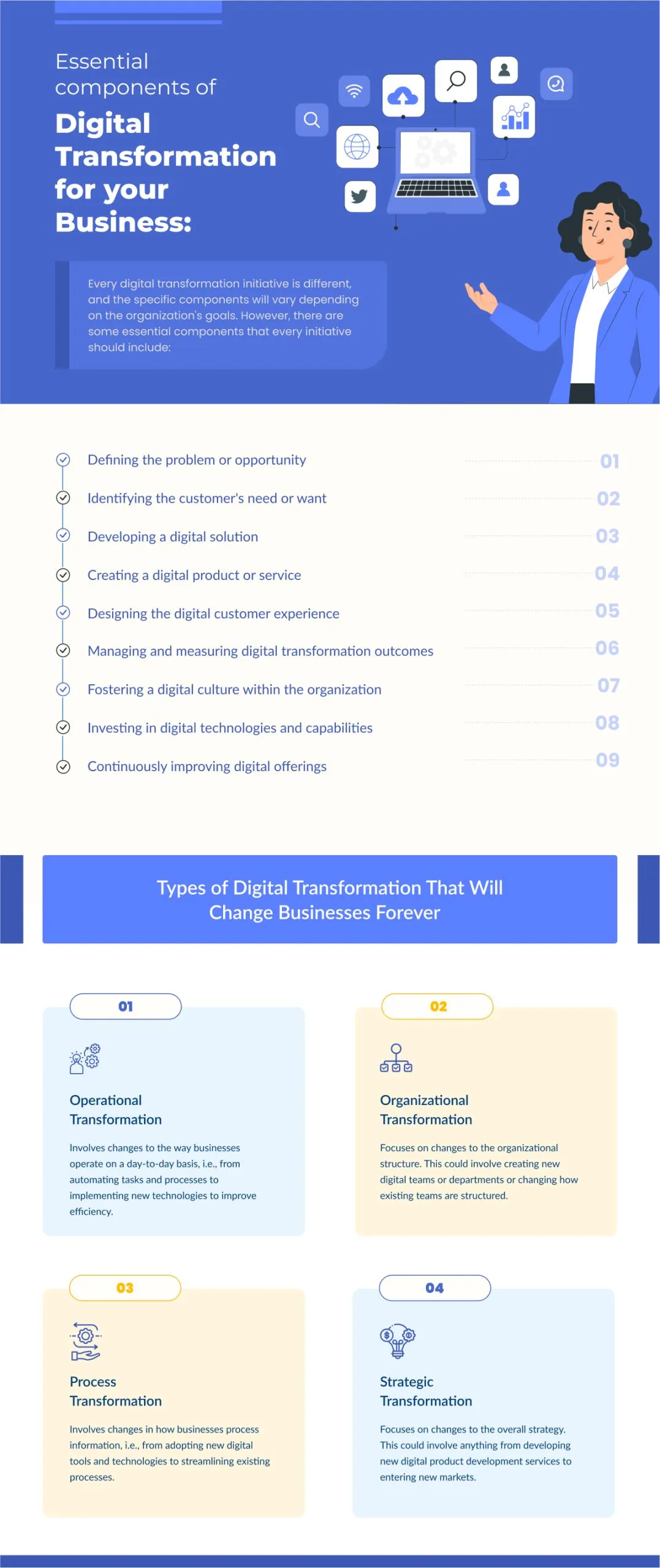Digital transformation has become one of the most popular business buzzwords as organizations realize the importance of digital technologies in changing how they operate and interact with customers.
It’s been there for over 25 years but only in recent times has it gained such popularity. Both Gartner & Forrester have placed Digital Transformation as one of their top 10 strategic trends for 2023–24, respectively.
It is simply because digital transformation is revolutionizing how organizations think about business. Instead of just looking at technology or IT departments, organizations are now thinking about how technology can change entire businesses from top to bottom.
This includes processes, revenue models, customer engagement, and more. Organizations that don’t adapt will be left behind by competitors who embrace digital transformation.
So what exactly is Digital Transformation? What does it mean? How can I get started with my strategy? What’s in store for us in 2022 and beyond? Let’s find out!
Let’s find out!
Digital Transformation: Must-have For Your Business Growth
Today’s business landscape is changing drastically, faster than ever before. Businesses must evolve simultaneously to keep up with the digital revolution taking place or risk getting left behind and even going out of business.
But, What exactly does this mean?
Essentially, digital transformation means building and creating new strategies around digital channels — online, mobile apps, etc. — to generate leads or revenue for your company.
Think of digital transformation as a corporate or business-wide strategy that deals with allocating more time/money to growing your digital channel presence so you can be more accessible to customers while they’re online.
Digital transformation doesn’t necessarily mean changing your product offerings; instead, think of it as an entirely new way of marketing to customers online.
Img src:Google
For example, if you sell sunglasses, digital transformation could look like developing an app that allows users to take photos of themselves in different outfits. After this, you will determine which pair of sunglasses goes best with their outfit (or even buy them directly from your app).
Digital transformation requires companies to develop new skill sets in areas like data analytics and artificial intelligence to tailor their products better based on customer behavior. It also requires companies to change their entire digital strategy, including leveraging digital asset management services to manage their growing digital resources effectively, and by rethinking everything from website design to social media engagement.
Also Read: How Artificial Intelligence Is Redefining Success Of Digital Transformation Strategies?
What If You Are A Startup
As a startup, the first step in digital transformation is to take a serious look at your current business model. Ask yourself these questions:
What are your products and services? What do they cost? Who buys them? How do people purchase those goods and services today? Are there ways that could be simplified or automated?
The goal of digital transformation is to take what you have now and repurpose it for an audience looking for something better, faster, more secure, or cheaper.
Get free consultation and let us know your project idea to turn it into an amazing digital product.
To achieve these goals, companies must identify three elements within their operations:
- Weaknesses that software/technology/systems can fix.
- Strengths that will allow them to capitalize on new opportunities.
- Competitors who stand in their way.
Once you’ve identified these factors, it’s time to start planning. Start with low-hanging fruit (improvements that require little investment) before moving on to bigger initiatives (which may require outside help).
It’s also important to remember that not all digital transformations are equal — some focus on functionality while others focus on revenue generation.
Whatever your end game, make sure everyone involved understands how their work fits into the bigger picture so everyone is working toward a common goal.
Who Needs Digital Transformation?
A business’s goals for digital transformation will be unique to that business. Every organization that wants to remain competitive and agile in today’s constantly evolving business environment is going digital.
In a nutshell, it’s about responding more quickly than your competitors to changing customer needs by offering new products and services digitally — whether that’s through mobile apps or websites.
It also requires businesses to be open to taking advantage of emerging technologies (like cloud computing) that allow for quick change and automation.
The new goal is operating at speed while maintaining quality. Digital transformation also implies a willingness on behalf of software product development companies to incorporate new ideas or people who can help them adapt in a way they may not have been able to continue doing otherwise — and a decreased reliance on older ways of doing things.
There are many key players involved in digital organizational transformation. Here are some of the most important:
- Senior leadership: This group provides the overall direction for the transformation and sets the tone for the entire organization. They also have the ultimate responsibility for ensuring that the transformation is successful.
- Transformation team: This team is responsible for leading the transformation effort and ensuring it stays on track. They work closely with senior leadership to ensure that the transformation meets its objectives.
- IT: This group plays a critical role in digital transformations, as they are responsible for implementing and managing the technology that will power the new digital organization.
- Business units: The business units are the groups within the organization that will be most affected by the transformation. They need to be closely involved in the process to ensure that their needs are met and that they can take advantage of the new digital capabilities.
- Employees: Employees will also be impacted by the digital transformation, both in terms of how they do their jobs and how the organization functions. It is important to involve them to ensure a smooth transition and get buy-in for the new digital organization.
Also Read: How Digital Transformation Is A Decisive Factor For Business Turnaround | Know Essentials
What Are The Top Digital Transformation Challenges?
With digital transformation becoming increasingly necessary for businesses, it’s important to be aware of the challenges you may face. By understanding and preparing for these challenges, you can increase your chances of success in making the digital shift.
People-centric issues: One of the biggest challenges in digital transformation is getting people on board. Change can be difficult for everyone, and employees may resist new technologies or working methods. Organizations need to ensure that their employees are trained and comfortable using new digital tools and processes.
Structural problems: Another challenge businesses face organizational structure. Many organizations are designed around traditional silos, making it difficult to implement digital transformations effectively. Businesses need to create more flexible structures that allow for collaboration and innovation to overcome this.
Technical barriers: Many digital transformations fail due to technical problems. Organizations need to ensure that their systems and processes are compatible with new digital technologies. They also need to have the right infrastructure to support digital tools and processes.
Selection of wrong tools: There are plenty of online tools for digital transformation. Some, like Slack, Salesforce, or Dropbox, are specifically designed. Others can be used even if you’re not explicitly trying to integrate them into your enterprise system.
In either case, it’s important to understand how these tools work in tandem with other business processes before implementing them.
Indefinite business goals: Before implementing any digital technology, you must know your business goals. Are you trying to increase sales? Reduce costs? Reach new customers? Determine these objectives before setting up a digital transformation project. Without these objectives in place, you won’t know whether or not a transformation is even worthwhile.
Establishing a Digital Hub: If you want your digital transformation efforts to succeed, it’s essential to create a space for collaboration — and it needs to be open enough that everyone can share insights from across your business.
While there are many software platforms on which you can do so, consider creating a digital hub with technologies such as social media, email marketing software, project management tools, video conferencing, and employee scheduling.
Finding New Opportunities: No business can stay competitive in today’s world without continuously improving its offerings and responding to changes in consumers’ needs.
Businesses are constantly seeking ways of giving customers what they want when they want it — and businesses face a wide range of potential challenges along that journey.
Get free consultation and let us know your project idea to turn it into an amazing digital product.
Get Ahead of the Curve: Tips for Developing a Successful Digital Transformation Strategy
Here are some tried-and-true tips for developing a successful digital transformation strategy — even if you’re new to the game. Let’s look at six key steps you can follow to ensure your strategy gets off on the right foot from Day 1.
1. Define your goals
Before developing a successful digital transformation strategy, you need to know what you want to achieve. What are your goals and objectives? What does success look like for your business? Be as specific as possible when defining your goals, as this will help you create a more targeted and effective strategy.
2. Conduct a digital audit
Part of developing a successful digital transformation strategy understands where your business currently stands regarding its use of technology. This means conducting a digital audit to assess your current infrastructure, processes, and systems. Identify any gaps or areas for improvement to focus your efforts on the right areas.
3. Engage stakeholders
Engaging stakeholders is another important step in developing a successful digital transformation strategy. It would be best if you got buy-in from key decision-makers within your organization so that they support and invest in your initiative. Furthermore, engaging stakeholders early on will help ensure that your strategy considers their needs and concerns.
4. Create a roadmap
Once you’ve defined your goals, conducted a digital audit, and engaged stakeholders, it’s time to start a roadmap for your digital transformation journey. This roadmap should outline the steps you need to take to achieve your goals, including the integration of AI for IT solutions, and timelines and budget considerations. Having a clear roadmap will help keep you on track and ensure that everyone involved is aware of the plan.
5. Implement and iterate
After you’ve created your roadmap, it’s time to start implementing your digital transformation strategy. This will likely be a gradual and ongoing process, so don’t expect everything to change overnight. Instead, focus on taking small steps and continually iterating based on feedback and results. Remember that a successful digital transformation is a journey, not a destination.
Also Read: Top 20 IT Consulting Companies To Seek For Business Transformation
Cutting-Edge Digital Transformation Strategies for Growth-Minded Businesses
Img src: Google
While digital transformation strategies have been growing in popularity, many businesses aren’t sure what they are or how to use them to help their business grow. By adopting the latest digital transformation strategies, businesses can stay ahead of the competition and better meet the needs of their customers.
There are many digital transformation strategies that businesses can adopt to improve their growth and competitiveness. Some of the latest digital transformation strategies include:
Adopting Cloud-based Technologies
Cloud-based technologies are one of the most important drivers of digital transformation. They enable businesses to be more agile, scalable, and efficient. By adopting cloud-based technologies, businesses can reduce their IT costs, improve flexibility, and accelerate their innovation.
Invest in User Experience
As user expectations change, businesses must rethink their strategies. The days of offering one product or service and hoping customers use it are long gone — it’s a buyers’ market, so you have to keep giving them more or risk losing them to your competitors.
To stay ahead of rivals, prioritize users with new digital transformation consulting services and offerings that reflect evolving customer preferences. Without a better digital experience, your business won’t stand a chance against bigger players.
Use Data Analytics to Determine Which Programs Are Working
Make data-driven decisions by working with your marketing team to evaluate whether a particular program produces desired results. This will help ensure that you and your marketing team stay focused on efforts that are producing results and saving time and money. Ultimately, you’ll be able to use data to determine which digital transformation strategies are working best, then double down on those efforts.
Follow Through with Online Reviews
Online reviews have become an important factor in customer satisfaction and brand reputation. Follow up on these online reviews with a handwritten note that thanks customers for their feedback and underscores your commitment to providing excellent service. Addressing customers by name (and including it in your note) is a great way to make them feel special. Thanking them helps ensure they’ll continue to support your business by word of mouth — and even by submitting more online reviews.
Partner With Other Brands to Offer New Products/Services
To stay competitive, it’s important to keep up with industry trends. One way to do that is by striking out on your own and offering products or services you don’t already offer, but another option is partnering with another company. By teaming up with another brand, you can provide customers with something new and exciting.
Post Pictures and Videos on Instagram
Posting videos or pictures of your product/service on Instagram is a great way to increase visibility and capture more leads. If you’re posting online content that includes photos or videos, then using Instagram as part of your strategy will be a simple transition since it uses similar tools. But even if you’re not creating visual content, Instagram could be right for you.
Nurture Communities On Facebook, Twitter, and YouTube
If you have a Facebook, Twitter, or YouTube account, ask your social media followers what they like about your business and what they wish was different. You can then use their insights to inform your strategy moving forward. Since your customers are really what drive customer satisfaction and even customer referrals, it’s important to stay in touch with them.
Start Podcasting
Podcasts provide an immersive listening experience and offer great opportunities to connect with your customers. While it’s possible to churn out a show on your own, you might want to consider hiring someone to host and create new episodes of your podcast. You can also spread out hosting duties by regularly recording episodes yourself or inviting other hosts to your show.
What Are The Benefits Of Digital Transformation?
Digital transformation is an attractive option for businesses looking to stay competitive in today’s digital world. By improving efficiencies and communication, reducing costs, and increasing revenues, digital transformation can help businesses in several ways.
Additionally, digital transformation can improve the overall customer experience. These factors make digital transformation an essential tool for businesses looking to stay ahead of the curve.
Img src: Google
1. Increased efficiency and communication: Digital transformation can help businesses streamline their processes and communications, making them more efficient overall. Additionally, digital tools can help employees collaborate more effectively, further improving efficiency.
2. Reduced costs: One of the main goals of digital transformation is to reduce costs. By automating processes and using digital tools, businesses can save money on labor, overhead, and other expenses.
3. Increased revenues: In addition to reducing costs, digital transformation can also help businesses increase their revenues. By tapping into new markets and understanding their customers better, businesses can boost their sales and grow their profits.
4. Improved customer experience: Digital transformation can improve the overall customer experience. By providing customers with personalized experiences and more convenient communication channels, businesses can make a lasting impression and build customer loyalty.
5. Increased employee satisfaction: Employees are happier, more fulfilled, and motivated in their roles when they feel empowered by technology. For example, remote access to company systems and programs lets employees work from home if they prefer a quieter or more flexible working environment.
6. Expanding global reach: As customers increasingly turn to digital platforms, consumers have more choices than ever before. Providing superior customer service across a wide variety of channels is essential for businesses that want to expand their reach, build brand loyalty and win new customers.
7. Enhancing customer loyalty: Going digital allows businesses to deliver a consistently seamless experience across all touchpoints. An omnichannel approach has produced a 15 percent increase in customer loyalty, while an integrated strategy offers up an extra 18 percent.
Companies that master multi-channel experiences have found that they can generate 50 percent more profit per year than those that don’t.
8. Embracing Technology: Companies that don’t embrace technological advances risk being left behind in a fast-paced, increasingly competitive marketplace. While digital transformation may seem like an ambiguous term, it simply means using new technologies to build up your business and gain a competitive edge — and you can do it without disrupting your daily operations.
The Future of Digital Transformation: Embracing Change in the Digital Age
The future of digital transformation is far from set in stone, and experts have different opinions on what that future holds. Some people believe that the internet of things will make life easier, while others believe we will see an increase in cyberattacks as systems become more interconnected.
The future of digital transformation will certainly be interesting to watch. Still, it’s up to you to determine what that future looks like by ensuring your business stays at the forefront of technology and digital trends.
Three scenarios in which we might see change
- Artificial Intelligence (AI)
- Internet of Things (IoT)
- Augmented Reality (AR) / Virtual Reality (VR)
With how fast information can travel nowadays and how easily it can be shared, technological advances are happening quicker. Just think about how different your daily routine would be without access to smartphones, social media, or online banking.
Get free consultation and let us know your project idea to turn it into an amazing digital product.
Conclusion
If you’re still on the fence about digital transformation, or if you feel like your business is too far behind to catch up, think again. The benefits of digital transformation are vast and can help businesses of all sizes get ahead of the curve.
It’s never too late to start; many companies are just starting their digital transformations now. So what are you waiting for? Get started today!
ValueCoders (one of the leading digital transformation services companies) provides a team of top custom software developers who can help you develop a successful digital transformation strategy that will have your business growing like never before. Ready to get started?
Contact us anytime!











